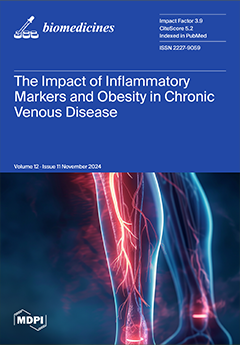Background: Microbial fermentation of non-digestible carbohydrates and/or protein produces short-chain fatty acids (SCFA), whereas branched-chain fatty acids (BCFA) are produced from protein fermentation. The effects of individual SCFA and BCFA of comparable carbon chain length on adipocyte inflammation have not been investigated.
Objective: To compare the effects of SCFA and BCFA on inflammatory mediator secretion in an adipocyte cell culture model designed to recapitulate obesity-associated adipocyte inflammation under normoxic and hypoxic conditions.
Methods: The 3T3-L1 adipocytes were cultured (24 h) without (Control, Con) and with 1 mmol/L of SCFA (butyric acid (But) or valeric acid (Val)) or 1 mmol/L of BCFA (isobutyric acid (IsoBut) or isovaleric acid (IsoVal)) and were unstimulated (cells alone,
n = 6/treatment), or stimulated with 10 ng/mL lipopolysaccharide (LPS, inflammatory stimulus,
n = 8/treatment) or 10 ng/mL LPS + 100 µmol/L of the hypoxia memetic cobalt chloride (LPS/CC, inflammatory/hypoxic stimulus,
n = 8/treatment).
Results: Compared to Con + LPS, But + LPS reduced secreted protein levels of interleukin (IL)-1β, IL-6, macrophage chemoattractant protein (MCP)-1/chemokine ligand (CCL)2, MCP3/CCL7, macrophage inflammatory protein (MIP)-1α/CCL3 and regulated upon activation, normal T cell expressed, and secreted (RANTES)/CCL5 and decreased intracellular protein expression of the ratio of phosphorylated to total signal transducer and activator of transcription 3 (STAT3) and nuclear factor kappa B (NFκB) p65 (
p < 0.05). Val + LPS reduced IL-6 secretion and increased MCP-1/CCL2 secretion compared to Con + LPS and exhibited a different inflammatory mediator secretory profile from But + LPS (
p < 0.05), indicating that individual SCFA exert individual effects. There were no differences in the secretory profile of the BCFA IsoBut + LPS and IsoVal + LPS (
p > 0.05). Alternatively, under inflammatory hypoxic conditions (LPS/CC) Val, IsoVal, and IsoBut all increased secretion of IL-6, MCP-1/CCL2 and MIP-1α/CCL3 compared to Con (
p < 0.05), whereas mediator secretion did not differ between But and Con (
p > 0.05), indicating that the proinflammatory effects of SCFA and BCFA was attenuated by But. Interestingly, But + LPS/CC decreased STAT3 activation versus Con + LPS/CC (
p < 0.05).
Conclusions: The decreased secretion of inflammatory mediators that is attributable to But highlights the fact that individual SCFA and BCFA exert differential effects on adipocyte inflammation under normoxic and hypoxic conditions.
Full article






